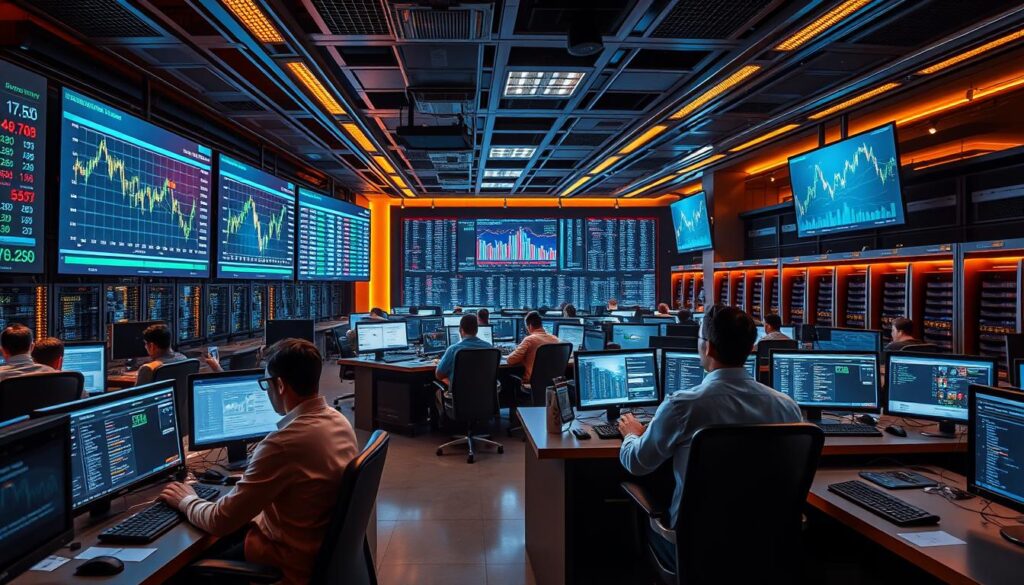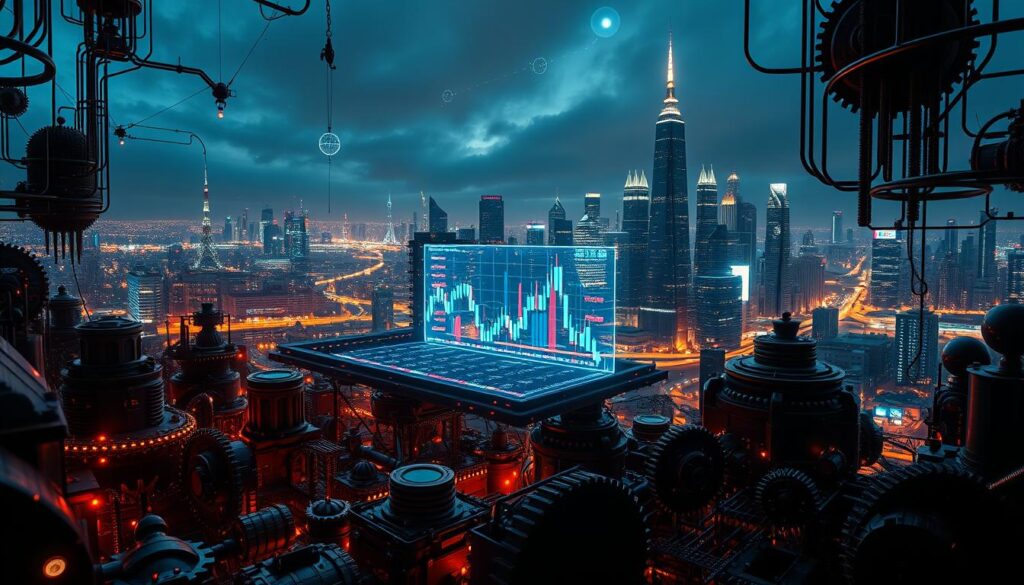Now Reading: AI Crypto Market Maker Algorithms Explained in Detail
- 01
AI Crypto Market Maker Algorithms Explained in Detail
AI Crypto Market Maker Algorithms Explained in Detail

Digital asset exchanges never close. They run all day, every day, across the globe. This constant activity creates a unique environment. It demands tools that can keep up with the fast pace.
Automated systems have become the backbone of modern digital finance. In 2023, their trading volume surpassed a staggering $94 trillion. These systems now handle over 70% of all transactions. This shift highlights a major change in how these markets function.
The role of providing constant buy and sell orders is crucial. This activity, known as market making, ensures smooth operations. It helps stabilize prices and supplies necessary liquidity. Without it, executing large trades would be much more difficult and costly.
Advanced technology brings a significant speed advantage. Automated systems can react in as little as 0.01 seconds. Human traders typically need at least 0.1 seconds to respond. This difference is critical in a landscape defined by rapid price movements.
This guide will explore the sophisticated technology behind these systems. We will cover everything from basic concepts to advanced techniques. You will learn how these powerful tools process vast amounts of data to create efficient trading environments.
Key Takeaways
- Digital asset markets operate 24/7, requiring non-stop, technology-driven solutions.
- Automated trading systems now execute the vast majority of transactions in this space.
- The primary function of market making is to provide constant liquidity and stabilize prices.
- Speed is a decisive advantage, with automated reactions far outpacing human capabilities.
- These systems analyze millions of data points to adjust their strategies in real-time.
- The technology represents a fundamental shift from traditional, manual trading methods.
- Understanding these algorithms is key to grasping the mechanics of modern digital finance.
Understanding the Basics of Crypto Market Making
The engine room of any active digital asset exchange is the constant flow of buy and sell orders. This vital activity, known as market making, provides the necessary liquidity for smooth operation. It enables other participants to execute their trading strategies efficiently.

What is Market Making?
Market making involves continuously quoting both buy and sell prices for an asset. Firms profit from the difference between these prices, called the bid-ask spread. In return, they provide a crucial service by ensuring liquidity.
These participants act as ready counter-parties to transactions. They step in when a natural buyer or seller is not immediately available. This prevents large gaps in the order book that can lead to significant price swings.
Key Differences from Traditional Markets
The landscape for digital assets presents unique challenges. Unlike traditional stock markets, these exchanges operate 24 hours a day, seven days a week. There are no trading halts or circuit breakers.
Extreme price volatility is another defining characteristic. Market making strategies must adapt in real-time to manage risk. The table below highlights the core contrasts.
| Feature | Traditional Markets | Digital Asset Markets |
|---|---|---|
| Operating Hours | Defined sessions (e.g., 9:30 AM – 4:00 PM) | 24/7 continuous operation |
| Primary Venues | Centralized (e.g., NYSE, NASDAQ) | Fragmented across global exchanges |
| Volatility Management | Circuit breakers, trading halts | Real-time, dynamic quote adjustment |
| Liquidity Provision | Concentrated on primary exchanges | Distributed across numerous platforms |
This demanding environment has spurred growth in specialized firms. Since 2020, professional market making services have brought greater sophistication to the space. They help maintain orderly and functional markets for all traders.
The Role of AI in Modern Cryptocurrency Trading
The journey of trading technology has been a remarkable evolution from basic automation to sophisticated, self-learning systems. This progression is particularly impactful in the fast-paced world of digital assets.

Evolution of Trading Technologies
Early automated strategies relied on simple, static rules. They executed trades only when specific, pre-programmed conditions were met.
This approach lacked flexibility. It could not adapt when broader market dynamics shifted unexpectedly. The table below contrasts these old and new methods.
| Feature | Rule-Based Algorithms | AI-Powered Systems |
|---|---|---|
| Logic Foundation | Static if-then statements | Dynamic machine learning |
| Adaptability | Limited; requires manual updates | High; learns and optimizes autonomously |
| Data Processing | Basic market data analysis | Real-time analysis of millions of data points |
| Decision Speed | Fast, but predetermined | Ultra-fast, with adaptive reasoning |
This shift represents a fundamental breakthrough. Systems now identify complex patterns and improve through experience.
Benefits of AI Integration
The advantages of this advanced technology are significant. Intelligent systems operate continuously without fatigue or emotional bias.
They can analyze vast datasets in real-time. This allows them to spot subtle trends that human traders might miss. Precision execution across multiple platforms is another key benefit.
This capability is crucial for understanding the role of artificial intelligence in creating a competitive edge. Firms using these tools gain measurable advantages in speed and insight.
Deep Dive: AI crypto market maker algorithms explained
Contemporary trading environments depend on advanced systems that process information at incredible speeds. These sophisticated tools analyze massive datasets to optimize liquidity provision.

How AI Enhances Liquidity Provision
Intelligent systems continuously monitor order book depth and trading volume across multiple platforms. They adjust bid-ask spreads dynamically based on real-time market conditions.
During volatile periods, these systems widen spreads to manage risk effectively. In stable conditions, they tighten spreads to capture more trading volume. This adaptive approach maintains consistent liquidity.
| Feature | Algorithmic Systems | Manual Trading |
|---|---|---|
| Reaction Time | 0.01 seconds | 0.1-0.3 seconds |
| Data Processing | Millions of data points | Limited human capacity |
| Pattern Recognition | Complex non-linear relationships | Basic trend identification |
| Market Coverage | Multiple exchanges simultaneously | Single platform focus |
Algorithmic Efficiency Compared to Manual Trading
The speed advantage of automated systems is substantial. While a human blinks, these tools can complete multiple trading cycles.
Deep learning models identify subtle patterns that escape manual analysis. They process historical data and technical indicators with remarkable precision. This leads to more accurate predictions and superior execution.
Research shows these advanced strategies consistently outperform traditional methods. They adapt to changing market conditions while maintaining efficient operations.
Market Data Analysis and Trading Strategy Optimization
Data-driven decision making has become the cornerstone of successful trading operations in digital finance. Sophisticated systems process enormous datasets to refine their approaches and enhance performance.
These tools transform raw information into actionable intelligence. They continuously adapt to changing conditions.
Leveraging Comprehensive Market Data
Modern systems integrate diverse information streams for complete market understanding. They combine historical price series with real-time order flow and trading volumes.
Additional sources include blockchain metrics and exchange liquidity data. This holistic approach provides deeper insights than single-source analysis.

Techniques for Detecting Trends and Patterns
Advanced methodologies identify recurring structures in financial data. Time series analysis and statistical modeling reveal emerging trends before they become obvious.
These systems excel at finding subtle correlations that escape manual detection. They might connect wallet activity with subsequent price movements.
Predictive analytics allow positioning ahead of expected market shifts. This proactive approach maximizes profitability through informed strategy adjustments.
Adaptive Trading Strategies with Reinforcement Learning
Unlike traditional programmed systems, reinforcement learning agents develop their strategies through continuous market feedback. This approach represents a significant advancement in how trading systems operate and adapt.
These systems learn through trial-and-error, much like humans gain experience. They receive rewards for profitable decisions and penalties for losses. This feedback loop creates constantly improving models.
Real-Time Adjustments Based on Market Conditions
Reinforcement learning enables dynamic responses to changing market conditions. Systems monitor volatility, liquidity, and order flow patterns continuously.
They adjust their positioning based on current conditions. This includes modifying quote depth and spread width. The goal is maximizing profitability while managing risk effectively.
Predictive Analytics and Strategy Refinement
Advanced machine learning techniques allow these systems to anticipate future market movements. They analyze historical patterns to predict volatility shifts.
This predictive capability helps refine trading strategies before changes occur. Systems can position themselves advantageously. This approach demonstrates the power of modern crypto trading algorithms.
The continuous learning process creates increasingly sophisticated trading approaches. These systems outperform static methods in risk-adjusted returns.
Enhancing Trade Execution and Liquidity Provision
Intelligent order routing represents a critical advancement in modern trading infrastructure. These systems focus on improving transaction quality while maintaining robust liquidity across fragmented platforms.
Sophisticated execution tools analyze each exchange’s unique characteristics. They learn fill patterns and hidden liquidity locations to optimize order placement.
Optimizing Order Placement Across Exchanges
Advanced systems distribute large transactions across multiple venues. This approach minimizes price impact that occurs from concentrated selling pressure.
Execution strategies adapt dynamically to changing conditions. When volume spikes, systems adjust routing to capture better fills.
| Feature | Basic Execution | Intelligent Routing |
|---|---|---|
| Order Splitting | Fixed size chunks | Dynamic sizing based on liquidity |
| Venue Selection | Manual or static rules | Real-time analysis of best prices |
| Adaptation Speed | Slow to market changes | Instant response to conditions |
| Slippage Control | Limited prediction capability | Advanced impact forecasting |
Reducing Slippage with AI-Driven Execution
Modern execution tools significantly decrease transaction costs. Research shows improvements of 10-20% compared to older methods.
These systems predict short-term price movements accurately. They prevent large orders from moving markets adversely.
The result is tighter spreads and deeper liquidity. All participants benefit from more efficient trading environments.
Risk Management and Mitigating Trading Risks in Crypto
Managing operational hazards represents a critical component of successful automated trading strategies. These systems face unique challenges that require comprehensive oversight frameworks.
Overfitting and False Signal Challenges
Intelligent systems can become over-optimized to historical patterns. This overfitting creates models that perform well on past data but fail with new conditions.
False signals from faulty data feeds or manipulated order books present additional risks. Robust validation methods help prevent catastrophic strategy failures.
Addressing Black Box Decision Concerns
Complex trading systems often function as opaque decision engines. This lack of transparency creates significant operational risk.
Human oversight mechanisms provide essential checks on automated decisions. Position limits and real-time monitoring help manage extreme volatility events.
Effective risk management requires balancing automation with human judgment. This approach ensures systems adapt to unprecedented market conditions.
Integrating AI with Blockchain and Market Surveillance
The convergence of blockchain technology and advanced computational systems creates new possibilities for market integrity. This integration addresses critical challenges in digital asset environments.
Distributed ledger technology provides an immutable foundation for trading activities. Every transaction receives permanent recording that cannot be altered.
Ensuring Data Transparency and Security
Blockchain’s transparent nature creates fully auditable trading environments. Participants can verify all activities without relying on third-party reports.
Intelligent monitoring tools scan these permanent records for unusual patterns. They detect potential security threats before they can impact market stability.
Oracle networks now incorporate validation mechanisms for external information. This ensures smart contracts receive accurate data for decision-making.
| Feature | Traditional Monitoring | Blockchain-Integrated Systems |
|---|---|---|
| Data Integrity | Relies on exchange reporting | Immutable on-chain records |
| Audit Capability | Limited to provided logs | Complete transaction history |
| Manipulation Detection | Pattern analysis only | Real-time + historical verification |
| Cross-Platform Coverage | Separate systems per exchange | Unified view across platforms |
Improving Regulatory Compliance Through Advanced Systems
Automated surveillance helps participants maintain compliance across jurisdictions. These tools continuously monitor for suspicious activities across multiple trading venues.
Regulators benefit from scalable monitoring capabilities that human teams cannot match. Suspicious pattern identification occurs in real-time rather than during periodic reviews.
The combination of transparent records and intelligent analysis creates robust compliance frameworks. This approach supports healthy market development while protecting all participants.
Opportunities and Challenges in AI-Powered Market Making
Firms implementing automated trading tools face a complex landscape of potential rewards and operational risks. The benefits are measurable, with hedge funds using these strategies outperforming peers by an average of 12%.
Machine-learning approaches delivered 5-7% higher returns in 2024 compared to traditional methods. This demonstrates clear advantages for early adopters.
Innovation versus Competitive Pressures
The space is becoming increasingly crowded. Many participants now compete for limited liquidity.
This creates aggressive pricing and reduced profit margins. What was once a competitive edge is becoming a basic requirement.
Continuous innovation is necessary just to maintain parity. The table below summarizes key dynamics.
| Aspect | Opportunities | Challenges |
|---|---|---|
| Performance | 12% average outperformance | Diminishing returns as adoption grows |
| Efficiency | 0.01s execution speed | Arm race requiring constant updates |
| Adaptability | Real-time strategy adjustment | Overfitting to historical patterns |
| Risk Management | Multi-source data analysis | Black box decision concerns |
Balancing Speed, Efficiency, and Risk
Successful operations require careful balance. Speed advantages must be weighed against potential system failures.
Investors benefit from tighter spreads and improved liquidity. However, traders face new complexities in strategy development.
The future will likely see continued evolution. Firms must adapt to both technological changes and market dynamics.
Future Trends: The Next 2-5 Years of AI in Crypto
Over the next half-decade, autonomous systems will fundamentally alter market dynamics and participant interactions. These emerging trends point toward more sophisticated financial instruments and evolving regulatory frameworks.
Emerging Financial Instruments and Market Models
New categories of derivatives and trading products will emerge, enabled by computational capabilities that were previously unavailable. Even minor digital assets with thin order books today may see dramatically improved liquidity.
As intelligent systems proliferate, they will interact in complex ways. Some may engage in adversarial strategies, attempting to exploit patterns in competing bots’ behaviors. This creates entirely new market dynamics.
Regulatory Evolution and Industry Adoption
Regulatory bodies are developing frameworks to address the unique challenges of automated trading. Potential requirements include pre-deployment testing and circuit breakers to prevent instability.
Widespread industry adoption will transform how digital asset markets operate. Decentralized exchanges are already implementing these technologies to optimize liquidity provision across multiple platforms.
Conclusion
As we conclude our exploration of automated trading systems, their transformative impact becomes clear. These intelligent technologies have fundamentally reshaped how digital assets are traded across global platforms.
The most successful approaches combine computational power with human judgment. This partnership creates robust strategies that adapt to changing conditions while maintaining essential oversight.
Looking ahead, these systems will continue evolving to handle greater complexity. The ultimate goal remains enhancing decision-making rather than replacing human insight entirely.
Firms that effectively leverage these tools while understanding their limitations will navigate future challenges successfully. This balanced approach benefits all participants in the digital finance ecosystem.
FAQ
What is the primary goal of a market maker in digital asset exchanges?
The main objective is to provide consistent liquidity by continuously quoting both buy and sell prices. This activity narrows the bid-ask spread, making it easier and cheaper for other participants to execute their trades.
How does artificial intelligence improve trading strategies over traditional methods?
Intelligent systems analyze vast amounts of market data in real-time. They can identify complex patterns and adjust strategies dynamically, leading to greater efficiency and better execution compared to manual approaches.
What are the key benefits of using machine learning for risk management?
Machine learning models excel at predicting volatility and identifying potential risks. They help traders manage exposure more effectively by providing data-driven insights for decisions, thereby mitigating potential losses.
How do these systems handle extreme volatility in cryptocurrency markets?
Advanced algorithms are designed to adapt quickly to sudden price swings. They can automatically adjust order placement and sizing to manage risk and capitalize on opportunities presented by high volatility.
What role does blockchain technology play in these trading platforms?
A> Blockchain provides a transparent and immutable record of all transactions. This enhances data security and auditability, which is crucial for regulatory compliance and building trust in automated trading systems.
Are there significant challenges associated with adopting these technologies?
Yes, challenges include the complexity of the models, the risk of overfitting to historical data, and the “black box” nature of some decisions. Continuous monitoring and refinement are necessary to ensure long-term success.
What future trends are expected in this sector over the next few years?
We anticipate greater adoption of decentralized finance (DeFi) protocols, more sophisticated predictive analytics, and evolving regulatory frameworks that will shape the development and use of automated trading tools.














